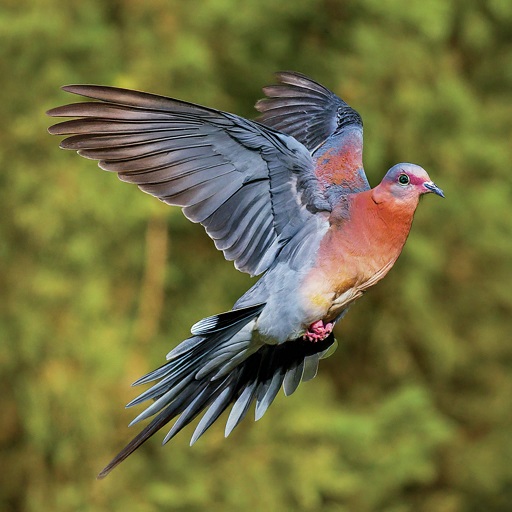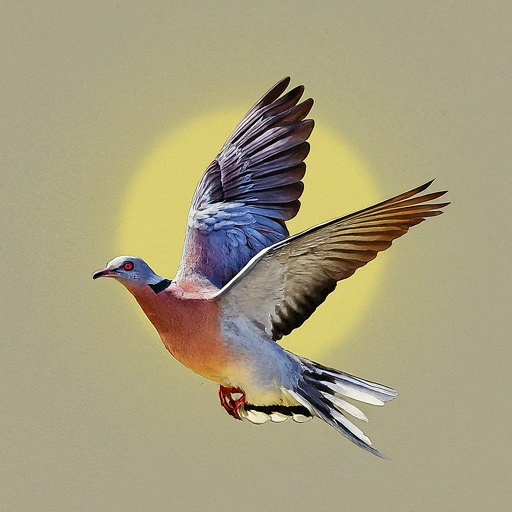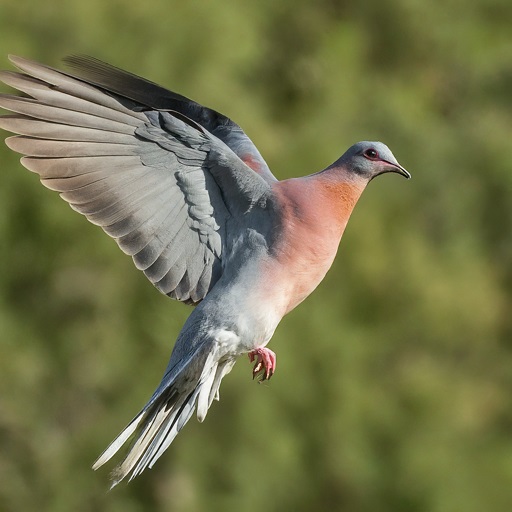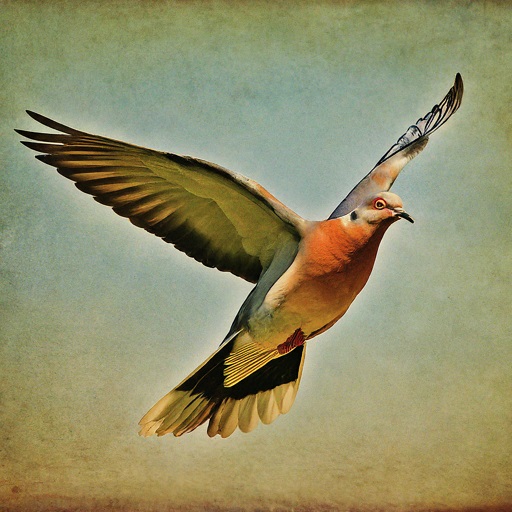Passenger Pigeon Habitat: Where Did The Passenger Pigeon Live?
If you want to learn about passenger pigeon habitat, you are in the right place. Undoubtedly the passenger pigeon was safe to be an extraordinary bird, known for his massive flocks that once filled the skies of North America. A study conducted by the Cornell Lab of Ornithology found that at the height of its population, there was an estimated 3 to 5 billion passenger pigeon at a time, making it one of the most numerous bird species on Earth ever.
To know more about their population numbers, you can be considered to read my article on ‘How many passenger pigeons were there.’ Coming back to the point, the astonishing number is hard to fathom, considering the current status of endangered species struggling to survive. Therefore, it raises a very important question: where did the passenger pigeon live? Let’s find out the passenger pigeon habitat when their population peaked without wasting time.
The Passenger Pigeon (Ectopistes migratorius) was an extraordinary bird known for its massive flocks that once filled the skies of North America. According to studies conducted by the Cornell Lab of Ornithology[^1^], there were an estimated 3 to 5 billion Passenger Pigeons at the height of its population, making it one of the most numerous bird species on Earth. This astonishing number is hard to fathom, considering the current state of endangered species struggling to survive.
The Passenger Pigeon’s population was so vast that its flock could darken the sky for days as they flew overhead. This impressive sight must have been awe-inspiring, and it is hard to imagine the abundance of life that once filled the North American continent.
Where Did The Passenger Pigeon Live?

The passenger pigeons were found across the vast range that stretched from eastern Canada to the southern regions of the United States. They were especially prevalent in the eastern part of North America, where dense forests provided them with ample food & nesting grounds. I learned about a research study by the American ornithologist union suggesting that the breeding ground of a passenger pigeon was mainly located in the deciduous forest of the Midwest and the Appalachian mountains.
During the breeding seasons, these passenger pigeons gathered in their favorite nesting area, forming massive colonies that covered square miles. Generally, this gathering was very important for them to successfully breed and get ultimate protection from the predators while allowing them to find suitable mates. You should also note that the passenger pigeon migratory habits were equally remarkable.
They used to travel in flocks that stretched for miles, moving in search of food & nesting sites. Their migration usually would take them across vast distances from the Northern reaches of their range to the southern region and back again. This kind of constant movement helped them follow the food availability cycle, ensuring they always had enough to sustain their enormous population.
Passenger Pigeon Habitat They Preferred
First, you should note that passenger pigeons are strongly tied to their food sources, particularly mast-producing trees like oak, beech, and chestnut. According to the study from the Smithsonian Migratory Bird Center, these passenger pigeons sought out areas abandoned in these fruits & nuts as they form the bulk of their diet.
Also, passenger pigeons’ keen ability to locate these food sources was determined by their movement factors which further led to large-scale migration. Their reliance on mast-producing trees also profoundly impacted the forest they inhabit. As they continued to forage for food, the passenger pigeon inadvertently aided in dispersing seeds.
This behavior also played a huge role in the regeneration & maintenance of forests, promoting overall biodiversity and ensuring the survival of various plant species. Apart from mast-producing trees, Passenger Pigeons also relied on other food sources, such as wild berries and insects. This kind of diverse diet made them adaptable to many different environments, further helping them thrive in different ecosystems throughout their vast range & seasonal fluctuations.
5 Key Features of Their Habitat
- The abundance of Food Sources: passenger pigeons often prefer habitats with vast forests rich in mast-producing trees, providing an abundant & reliable food source for the birds.
- Need for Freshwater: Also, the passenger pigeon habitat was categorized by the presence of nearby water bodies that were crucial for their survival. Since they will need to access the fresh water for drinking & bathing, they often house somewhere near a water body amidst the forest.
- Ideal Nesting Grounds: When building nests, this peculiar passenger pigeon usually prefers tall & mature trees with dense foliage to protect their eggs and young ones from predators.
- Migratory Routes: unlike any other bird species, passenger pigeons are known to follow specific migratory routes, allowing them to navigate efficiently between breeding and non-breeding areas.
- Social Behavior: Passenger pigeons are highly sociable creatures, and their gregarious nature led to the formation of massive flocks, providing safety & opportunity for successful breeding.
Passenger Pigeon & The Ecosystem
Also, it is worth noting that the passenger pigeon played a critical role in shaping the ecosystem of the forest they inhabit. As I told you earlier, their feeding behavior also contributes to seed dispersal, which further aids in forest regeneration. This created a cyclical relationship as the forest provided for the passenger pigeons while the passenger pigeons helped maintain the health & diversity of the forest ecosystem.
Not only did the passenger pigeon aid in seed dispersal, but their dropping also served as Natural fertilizer, enriching the soil and promoting vegetation growth. Their droppings were nitrogen-rich, enhancing the habitat for many other species that relied on this forest for survival. Also, you should note that passenger pigeons can significantly impact the ecosystem, extending to other wildlife.
The passenger pigeon attracted predators like wolves, foxes, and raptors, who actively followed passenger pigeons in search of food. This kind of ripple effect also demonstrates the interconnectedness of species within an ecosystem where the presence & absence of one species could have far-reaching consequences for others.
Tragic Decline & Extinction
Unfortunately, the passenger pigeon faith took a tragic turn; despite their vast numbers, they became extinct. If you want to know more about why the passenger pigeon went extinct, consider reading my articles on ‘the passenger pigeon extinction cause.’ The major culprit behind their extinction tends to be hunting for these birds, which became a lucrative business in the 19th century, with large-scale commercial hunting & exploiting the abandoned population.
Also, a study conducted by the national society revealed that the railroad development made it easier for hunters to transport large quantities of passenger pigeons into cities where their meat was in high demand. As European settlement expanded across North America, the seemingly endless forest began to shrink due to continuous deforestation.
It also destroyed the passenger pigeon’s preferred habitat, further exacerbating the population decline. You should know that large flocks make them an easy target for hunters who use their shotguns & nets to capture as many birds as possible. This kind of uncontrolled hunting, combined with habitat destruction, also rapidly declined their number. Below I have mentioned the passenger pigeon population declining over time until they became extinct in 1914, when the last female passenger pigeon, Martha, took its last breath and died on September 1st, 1914.
| Year | Estimated Population |
| 1800 | 3 billion |
| 1850 | 1 billion |
| 1900 | Few thousand individuals |
| 1914 | Extinct in the wild |
Lessons from the Tragedy
It is not only very sad to hear the unfortunate story of a passenger pigeon, but also, we must understand the lessons from this tragedy. Indeed, the story of passenger pigeons serves as a grim reminder of the consequences of unchecked exploitation of natural resources. It further highlights the importance of responsible hunting practices and a conservation effort to preserve endangered species.
An article by the Union of concerned scientists stresses that studying the Passenger Pigeon’s decline can help us avoid similar fates for other vulnerable species. Therefore l, we must become proactive & learn from our past to understand what kind of action can have far-reaching consequences for the natural world. Also, we should consider the preservation of habitats, responsible resource Management, and sustainable practices to ensure the survival of endangered species and maintain a delicate balance of the ecosystem.
Conservation Efforts & The Hope For Reintroduction
There are many rumors when it comes to knowing about the hope for de-extinction. However, we have also shared an in-depth article on passenger pigeon revival, where I have discussed the possibility of bringing back passenger pigeons. Do consider checking my other article, where I discussed the potential for the extinction of passenger pigeons and the ongoing passenger pigeon revival project.
Even though the extinction of passenger pigeons seems to be a very complex & controversial topic, scientists are exploring the possibility of using genetic engineering to bring back a species that once played a significant ecological role. Even though some argue that it could correct past mistakes and restore pigeon diversity, others caution against potential unintended consequences and the need to private-eye existing endangered species conservation.
In the face of extinction & habitat loss, conservation efforts are becoming more & more critical than ever. Therefore, make sure that we consider working with other organizations & government bodies actively to protect & preserve endangered species’ habitats and implement sustainable practices to safeguard biodiversity. Below I have mentioned some of the endangered species with their conservation status.
Species | Conservation Status |
| Passenger Pigeon | Extinct |
| California Condor | Endangered |
| Black-footed Ferret | Vulnerable |
Conclusion
I hope now you know ‘where the passenger pigeon lives,’ if so, consider sharing this article to appreciate my effort. You should note that the last passenger pigeon mentioned in this article is intentional because its story serves as a poignant reminder of the delicate balance between humans and nature. It is important that you also understand and learn from this kind of tragedy so we can work together to protect & preserve the habitat of endangered species while ensuring a sustainable future for all living beings.
Being the most intelligent creatures on Earth, we are responsible for being stewards of the environment to protect and conserve the diverse biodiversity surrounding us. If we continue to learn from our past mistakes and implement better practices, we can hope for a world where species like passenger pigeons can again thrive and grace our skies.
If you find this article helpful, then consider sharing it. Your share will help many people learn about the passenger pigeon’s habitat or where the passenger pigeon lives. Check my other helpful guide on passenger pigeon facts & figures shared on this website. See you in the next post, till then, take care & goodbye.




